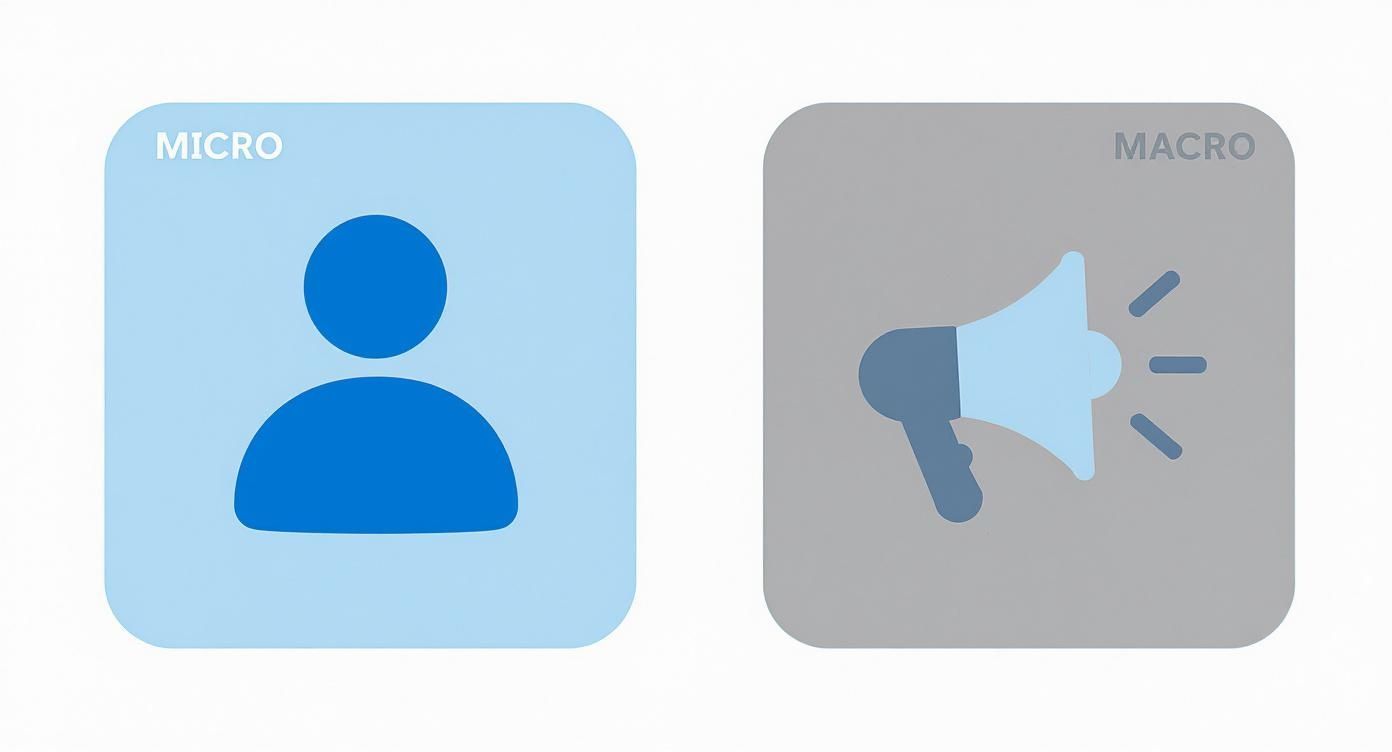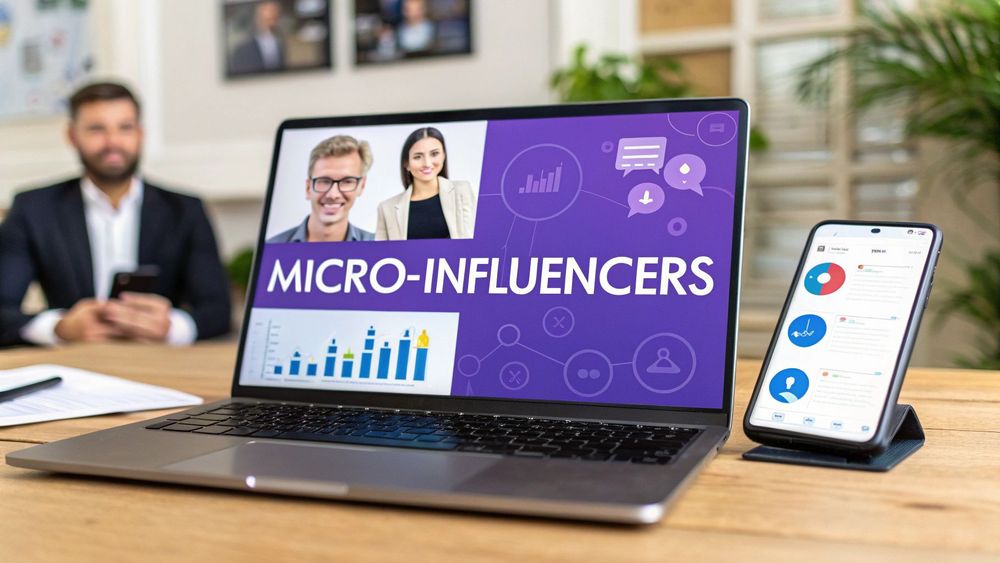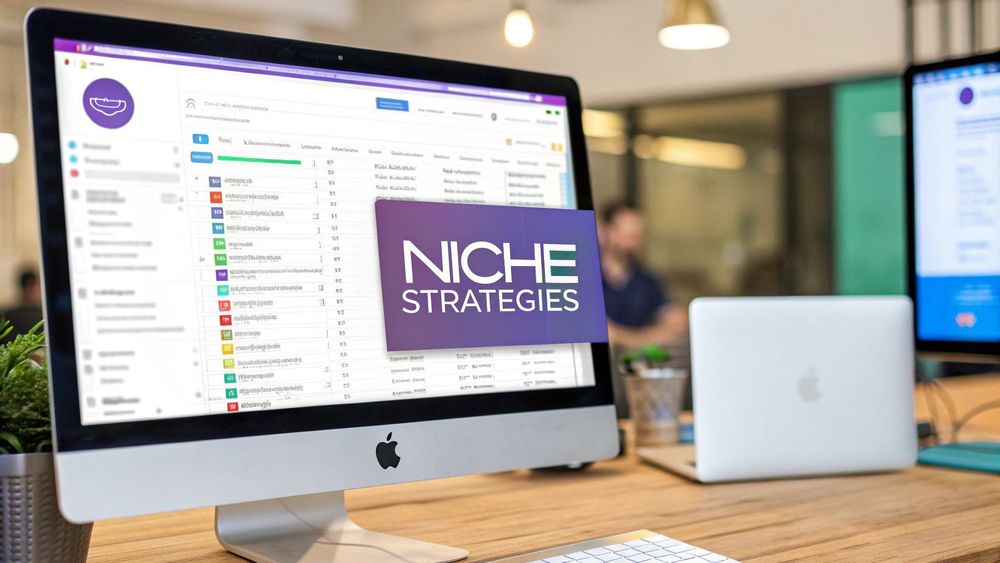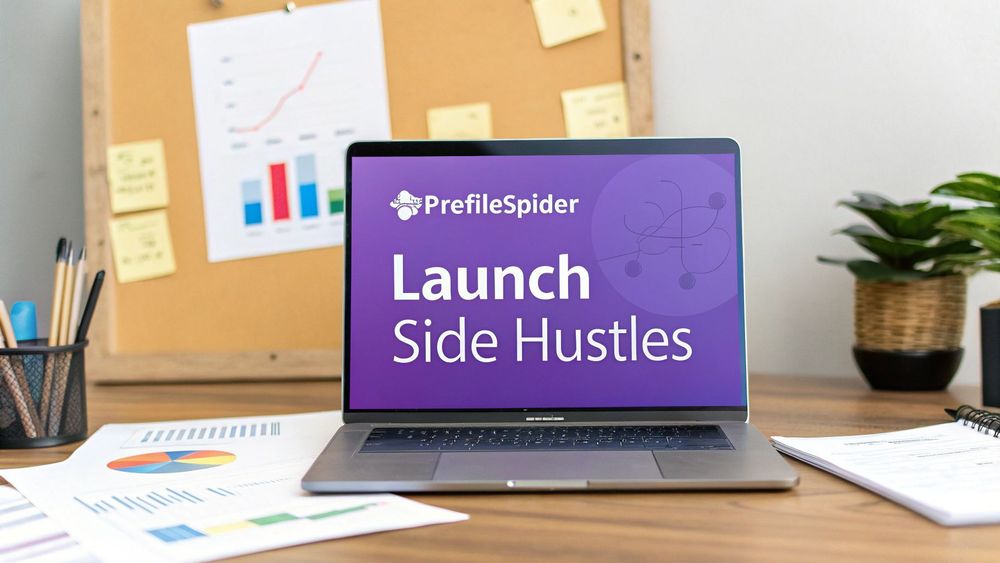When most marketers hear the word "influencer," their minds immediately jump to big names with massive, sprawling audiences. But in the world of B2B, that's not where the real action is. The true power lies with micro-influencers—those niche experts with smaller, yet fiercely engaged, followings.
Activating these credible voices isn't about chasing vanity metrics. It's about building genuine trust and reaching key decision-makers in a way that broad, celebrity-style campaigns simply can't.
Why Niche Experts Are Your New Growth Engine
Let's be honest, the old B2B marketing playbook is getting stale. Buyers are more skeptical than ever. They tune out generic brand messaging and are actively hunting for authentic, expert-driven insights to help them solve their biggest, most complex problems.
This is exactly where micro-influencers come in. These are the folks with real, boots-on-the-ground credibility in their specialized communities, and they can be a potent growth engine for your brand.
Unlike macro-influencers who offer wide but shallow reach, micro-influencers deliver surgical precision. Their value isn't measured in follower counts; it's measured by the strength and quality of the relationship they have with their audience. We're talking about the practitioners, consultants, and industry analysts who live and breathe their subject matter. They don’t just talk about industry trends—they're the ones creating them.
Before we go deeper, it's helpful to see how these two types of influencers really stack up in a B2B context.
Micro vs Macro Influencers in B2B Marketing
| Attribute | Micro-Influencers (1K-100K Followers) | Macro-Influencers (100K+ Followers) |
|---|---|---|
| Audience | Niche, highly-targeted, and deeply engaged professionals within a specific industry. | Broad, diverse, and often less specialized. |
| Credibility | High. Perceived as peers and genuine experts with hands-on experience. | Varies. Often seen as personalities or entertainers rather than practitioners. |
| Engagement | Significantly higher. Their recommendations feel like advice from a trusted colleague. | Lower on average. Interactions can be more superficial. |
| Cost | More affordable, offering a higher ROI for targeted campaigns. | Can be extremely expensive, with costs rising with follower count. |
| Accessibility | Generally more approachable and open to building long-term partnerships. | Often managed by agencies, making direct, personal connection difficult. |
| Content | Authentic, in-depth, and practical. Resonates deeply with their specific audience. | Polished and professional, but can sometimes lack the "in-the-trenches" feel. |
The takeaway is clear: for B2B marketers trying to influence complex buying decisions, the depth and authenticity of micro-influencers almost always outweigh the broad-stroke appeal of macro-influencers.
The Power of Authentic Credibility
In technical fields like cybersecurity, fintech, or HR software, trust isn't just a nice-to-have; it's the most valuable currency you can earn.
Think about it: a recommendation from a respected peer carries infinitely more weight than a polished advertisement ever could. Micro-influencers have earned this trust the hard way—through years of experience and consistent, valuable contributions to their field. Their endorsement feels less like a promotion and more like a trusted colleague sharing invaluable advice. This level of authenticity is absolutely critical when you're trying to influence a complex buying decision that often involves multiple stakeholders and a hefty budget.
The data backs this up. A recent Sprout Social Pulse Survey found that 67% of B2B brands cite increased brand awareness as their primary goal for influencer collaborations. Micro-influencers are becoming a huge part of this strategy because they deliver targeted awareness that actually moves the needle. You can dig into more of the numbers by reviewing these influencer marketing statistics.
From One-Off Campaigns to Always-On Relationships
The most effective B2B influencer marketing isn't about splashy, one-off campaigns. It's about building long-term, 'always-on' relationships that transform into a sustainable marketing asset for your business.
By consistently collaborating with a core group of niche experts, you build a powerful network of advocates who amplify your message authentically, day in and day out. This approach doesn't just get your name out there; it establishes your brand as a central, indispensable player in key industry conversations.
An always-on strategy transforms influencers from temporary megaphones into long-term strategic partners. It creates a continuous feedback loop, providing your brand with invaluable market insights while cementing your authority within a niche community.
This sustained engagement model delivers compounding returns over time. In fact, research shows that a staggering 99% of marketing teams who use an always-on approach rate their influencer programs as effective. Instead of chasing fleeting viral moments, you're building a rock-solid foundation of trust that drives consistent lead generation and strengthens your brand's reputation for years to come.
Finding Your Ideal B2B Micro-Influencers
Let’s be honest: finding the right B2B micro-influencers can feel like a total grind. The old-school way involves sinking hours into manually trawling through LinkedIn hashtags, industry forums, and conference speaker lists. It's a tedious, manual process that brings your entire marketing motion to a crawl.
The Traditional Method: Manual Research and Spreadsheet Chaos
For marketers, the traditional approach to building an influencer list is painfully manual. It starts with an endless series of searches on LinkedIn for keywords like "fintech consultant" or "cybersecurity expert." You click through dozens of profiles, copy-pasting names, job titles, and profile URLs into a sprawling spreadsheet. Then, you hunt for contact information, cross-reference their activity on other platforms, and try to organize the messy data. This process can take days, and the final list is often incomplete and prone to errors.
The ProfileSpider Way: Automated Discovery in a Single Click
A modern approach flips the script by automating that painful first step. With a tool like ProfileSpider, you turn those same LinkedIn searches or conference attendee pages into a clean, organized list of potential partners in just one click. Instead of manual data entry, the AI-powered extractor grabs complete profiles—names, job titles, companies, locations, and social links—and saves them instantly.
All the data is stored locally in your browser, ensuring complete privacy and GDPR compliance. This transforms a week of tedious work into a few seconds of efficient, no-code data collection, letting you focus on vetting candidates and building relationships.
This infographic breaks down the key differences between micro-influencers and their macro-level counterparts, especially when it comes to reach and engagement.

As you can see, while macro-influencers offer a massive audience, it's the micro-influencers who deliver the focused, high-engagement conversations that actually move the needle in B2B.
Where to Look for B2B Niche Experts
Once you know who you’re looking for, you’ll need some effective methods to find B2B influencers who genuinely fit your brand and audience.
You want to focus your search on the platforms where the real professional conversations are happening:
- LinkedIn: This is the undisputed hub for B2B. Look for people who consistently share insightful content, jump into relevant group discussions, and have actually built a following around their expertise. For a deeper dive, check out our guide to prospecting on LinkedIn.
- Industry-Specific Forums & Communities: Niche communities, whether on Slack or dedicated forums, are absolute goldmines. This is where you find the true experts who are neck-deep in the day-to-day challenges of your industry.
- Conference & Webinar Speaker Lists: Anyone invited to speak at an industry event has already been vetted. Their credibility and authority are established, making them prime candidates.
Key Takeaway: The goal here isn't just finding people with a follower count. You're looking for the active, respected players in the exact conversations your ideal customers are already tuned into.
Building Your Prospect List with One-Click Extraction
So you've found a promising source, like a LinkedIn search for "Fintech Consultants." Now comes the data collection. Manually copying and pasting profile after profile is not just boring; it's a massive waste of your time.
This is exactly where a one-click profile scraper like ProfileSpider becomes your best friend. Its universal extraction engine works on LinkedIn or any other website with profile information.
With a single click, ProfileSpider captures all the relevant profile data from the page. It instantly turns that messy, unstructured web data into an organized and exportable file, saving your team hours of mind-numbing work. You can create custom lists, tag profiles, and export everything to CSV or Excel to integrate with your CRM. By automating this initial data-gathering step, you free up your energy for the more strategic—and more important—tasks of vetting candidates and building genuine relationships.
How to Vet and Qualify Your Influencer Shortlist
Okay, so you've got a long list of potential influencers. That's a great start, but it's just that—a start. Now for the really important part: filtering that list down to the true gems who can actually move the needle for your business. This is where you have to look past the flashy follower counts and dig into what really matters.

Does their audience actually include your ideal customers? Are their comment sections sparking real, insightful conversations, or are they just a sea of fire emojis and "Great post!"? Most importantly, does their professional background give them genuine credibility in your space?
Look Beyond the Numbers
The first thing you have to do is train yourself to ignore vanity metrics. A big follower count looks impressive, but it can be incredibly misleading. You need to do a deep-dive into the quality of their engagement and, critically, the relevance of their audience.
- Audience Demographics: Who is following them? Are they the right job titles, in the right industries, and in the right countries? A B2B influencer's real value is their access to specific professional circles.
- Engagement Quality: Don't just glance at the number of likes. Get in there and read the comments. Are people asking thoughtful questions? Are they tagging colleagues to pull them into the discussion? That's the sign of a truly engaged community, not just passive scrollers.
- Content Relevance: Does their content actually align with your brand's message and expertise? You're looking for a consistent track record of posts that show they know what they're talking about in your niche.
This manual review is non-negotiable. The global influencer marketing industry is on track to hit $32.55 billion, and B2B marketers are getting smarter about how they find partners. In fact, 66.4% of marketers say AI tools have boosted their campaign results by helping them analyze engagement, audience data, and content relevance more effectively. You can find more stats on the growth of influencer marketing in this report.
Spotting Red Flags
While you're looking for all the right signals, it's just as important to keep an eye out for red flags that could completely derail your campaign.
A partnership with the wrong influencer doesn't just waste budget; it can damage your brand's credibility. Careful vetting protects your investment and reputation by ensuring every partner is authentic, respected, and aligned with your goals.
Keep an eye out for these warning signs:
- Inconsistent Engagement: If a post has thousands of likes but only a handful of generic, one-word comments, something's fishy. It could be a sign of fake followers or bought engagement.
- Overly Promotional Content: An influencer whose feed is just one sponsored post after another probably has a transactional audience that's learned to tune out ads. You want a partner who balances sponsored content with genuine, organic value.
- Lack of Professional Credibility: Does their claimed expertise on one platform match their actual professional history on a site like LinkedIn? In B2B, authenticity is everything.
By creating a simple vetting checklist using these criteria, you can work through your shortlist systematically. This process ensures that every micro-influencer you decide to reach out to is not just popular, but genuinely influential with the exact people who matter most to your business.
Crafting Outreach That Actually Gets a Reply
Let’s be honest: your first impression is everything. After all that work vetting your shortlist, you’ve finally reached the outreach stage—and this is precisely where most B2B influencer campaigns die a quiet death. Generic, templated emails don't just get ignored; they get deleted on sight.
To get a reply, your outreach needs to be personal, professional, and laser-focused on what’s in it for them.

Forget mass emails. B2B micro-influencers are busy professionals who can spot a copy-paste job from a mile away. Your goal here is to prove you've done your homework and genuinely value their expertise, not just their follower count.
Personalization Is Non-Negotiable
Start by referencing something specific they've created or said. Did their recent LinkedIn post on AI in supply chain management catch your eye? Did a particular point in their conference talk on cybersecurity trends really hit home? Mention it. Right in your opening line.
This simple act of acknowledgment does two things. First, it proves you aren't just blasting out a cold list. Second, it shows you respect their work, immediately setting your message apart from the dozens of generic requests clogging their inbox.
Pro Tip: Keep your first email short and sweet. Introduce yourself, state the specific reason you're reaching out (that’s where you reference their work), and then suggest a simple, low-commitment next step, like a quick 15-minute chat.
Structuring a Compelling Proposal
Once you get a positive response, you can follow up with a more detailed proposal. The key is to frame the entire opportunity around the benefits to them. How will this collaboration elevate their personal brand, give them valuable content for their own channels, or introduce them to a new, relevant audience?
Think about different ways you could work together:
- Co-hosted Webinar: You handle all the boring logistics and promotion, letting them shine as the star expert.
- Featured Expert in a Research Report: Showcase their insights in a high-value asset they'll be proud to share with their own network.
- Sponsored Content Series: Fund a series of LinkedIn posts or a short video where they can dig into a topic they’re already passionate about.
If you need some inspiration, exploring different blogger outreach email templates can give you a great starting point for structuring your own messages.
Navigating Compensation and Building Relationships
When it comes to compensation in B2B influencer marketing, it's not always about a simple cash payment. While many established creators will expect a fee, others might be open to non-monetary value, especially if the partnership offers them significant brand-building perks.
Be ready to talk through a few different models:
- Paid Partnerships: This is the most straightforward—a flat fee for specific deliverables. It's the standard for experienced creators.
- Affiliate Models: A commission-based setup where they earn a cut from any leads or sales they generate.
- Value Exchange: This can get creative. Think free access to your premium software, cross-promotion to your company's audience, or even valuable networking introductions.
Ultimately, your goal shouldn't be a one-off transaction. It should be the beginning of a real relationship. If you approach every conversation as the start of a long-term partnership—with flexibility, respect, and a focus on mutual value—you’ll craft outreach that doesn’t just get a reply. You'll build a powerful network of advocates for your brand.
Measuring Success and Proving Campaign ROI
So you’ve launched your B2B influencer campaign. Don't pop the champagne just yet—the real work of proving its value has just begun. To justify the investment and lock down future budget, you absolutely have to move beyond vanity metrics like likes and shares. You need to draw a straight line from your influencer's activity to real business results.
The trick is to track what actually matters for your specific goals. Are you trying to build top-of-funnel awareness? Drive mid-funnel engagement? Or are you focused squarely on bottom-funnel conversions? Each objective needs its own set of Key Performance Indicators (KPIs).
Defining Your Core Metrics
Before you can measure success, you have to define what "success" even looks like for this campaign. Your KPIs should tie directly back to the goals you set at the very beginning.
- For Awareness: Keep your eyes on metrics like impressions, reach, and share of voice. These numbers tell you how many people are seeing your brand because of an influencer and how that stacks up against your competitors.
- For Engagement: Here, you'll want to monitor comments, shares, and click-through rates (CTR). Meaningful comments and lively discussions are gold—they're a clear sign that the influencer's message is hitting home with their audience.
- For Conversions: This is where you prove the real ROI. Track the hard numbers: demo requests, ebook downloads, free trial sign-ups, or webinar registrations coming directly from your influencer partners.
This focus on tangible results isn't just a good idea; it's becoming the industry standard. Research shows that B2B brands are seeing an average return of $5.20 for every $1 spent on influencer marketing, and micro-influencers often punch well above their weight, delivering even better returns. You can get a deeper look into how B2B marketers are thinking about their budgets by reading the full research on B2B influencer marketing.
Attribution and Tracking Made Simple
To actually measure those conversions, you need a reliable tracking system. Without it, you’re just guessing. Thankfully, setting up a solid attribution model is more straightforward than you might think.
Don’t let attribution be an afterthought. Using unique tracking links for each influencer is the single most important step you can take to prove the direct impact of your program on lead generation and sales.
Make sure you implement these two tools for every single influencer you activate:
- UTM Parameters: Create unique, trackable URLs for each influencer and campaign. This is non-negotiable. It lets you see exactly how much traffic and how many leads each specific partner is driving right inside your analytics platform.
- Dedicated Landing Pages: For bigger campaigns or key partners, a custom landing page is a game-changer. It creates a seamless experience for the user and makes it incredibly easy to isolate and measure all the traffic and conversions generated from that one source.
To give you a clearer picture, here’s a quick breakdown of the KPIs you should be watching, depending on what you're trying to achieve at each stage of the funnel.
Key Performance Indicators for B2B Influencer Campaigns
| Campaign Goal | Primary KPI | How to Measure |
|---|---|---|
| Top-of-Funnel (Awareness) | Impressions & Reach | Total views and unique viewers on influencer content. |
| Share of Voice | Brand mentions vs. competitor mentions in the target niche. | |
| Mid-Funnel (Engagement) | Click-Through Rate (CTR) | Clicks on your unique UTM link divided by total impressions. |
| Engagement Rate | (Likes + Comments + Shares) / Total Followers. Look for quality comments. | |
| Bottom-of-Funnel (Conversion) | Leads Generated | Demo requests, trial sign-ups, or content downloads from the UTM link. |
| Cost Per Lead (CPL) | Total campaign cost divided by the number of leads generated. |
By pairing clear KPIs with a robust tracking system, you can stop making assumptions. The data you collect will not only prove the campaign's success but also give you invaluable insights to make your next one even better. The logical next step is automating the follow-up for these new leads; you can explore some practical ideas in our guide to marketing automation workflow examples. This way, you can walk into any meeting and confidently communicate the value of influencer marketing to leadership, backed by cold, hard data.
Got Questions About B2B Micro-Influencer Marketing?
Even the best-laid plans run into real-world questions once you're in the trenches. It's totally normal. Here are some quick, straight-to-the-point answers for the stuff that comes up most often.
How Much Should I Actually Budget for a Micro-Influencer?
This is the million-dollar question, isn't it? Unlike B2C, there's no standard rate card for B2B experts. You're paying for niche expertise, not just eyeballs, so compensation really depends on their specific industry, experience, and what you're asking them to do.
Some up-and-coming voices might be open to collaborating for non-monetary value, like free access to your product or some cross-promotion. But let's be real: most established B2B creators expect to be paid for their time and the credibility they bring to the table. Think in terms of project fees, not per-post rates.
My Two Cents: A fair budget is all about the value you're getting, not just the follower count. For something like a multi-post LinkedIn campaign or a webinar appearance, a budget of $500 to $2,500 per micro-influencer is a solid starting point. Of course, this can scale up depending on the influencer's authority and the complexity of your campaign.
What Are the Best Platforms Besides LinkedIn?
Look, LinkedIn is the undisputed king of B2B. No arguments there. But if that's the only place you're looking, you're missing out on where the real, unfiltered conversations are happening. The most authentic experts are often hyper-active in smaller, more focused communities.
You need to go where your audience goes for genuine advice.
- Industry-Specific Slack & Discord Communities: These are absolute goldmines. You'll find experts who are deep in the weeds, solving the exact problems your customers face every single day.
- Niche Forums and Subreddits: Think about the online hangouts where practitioners in your field go to ask the tough questions and share what actually works. That's where you'll find them.
- Professional Associations: Don't sleep on these. True experts often contribute to content and lead discussions within their formal industry groups.
Expanding your search to these spots helps you find influencers who've built trust in the places your ideal customers are already looking for answers.
What if a Campaign Totally Bombs?
It happens. Not every campaign is going to be a home run, and that's okay. The trick is to have a game plan for when performance just isn't hitting the mark. First thing's first: analyze the data without getting emotional about it.
Did the content just not resonate with their specific audience? Was the call-to-action buried or confusing? Maybe the timing was just off.
Once you have a theory, have an open and honest conversation with your influencer. Don't point fingers; share the data and collaborate on a fix. Seriously, a small tweak to the messaging or even trying a different content format can often turn things around. Treat it as a learning opportunity to sharpen your strategy for the next one. A "failure" can quickly become your most valuable insight.




